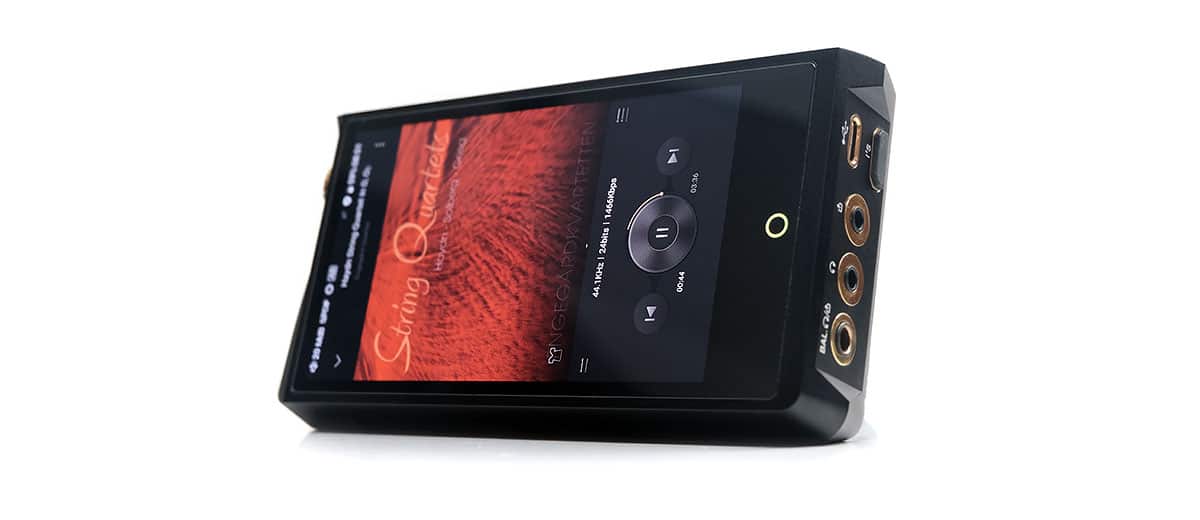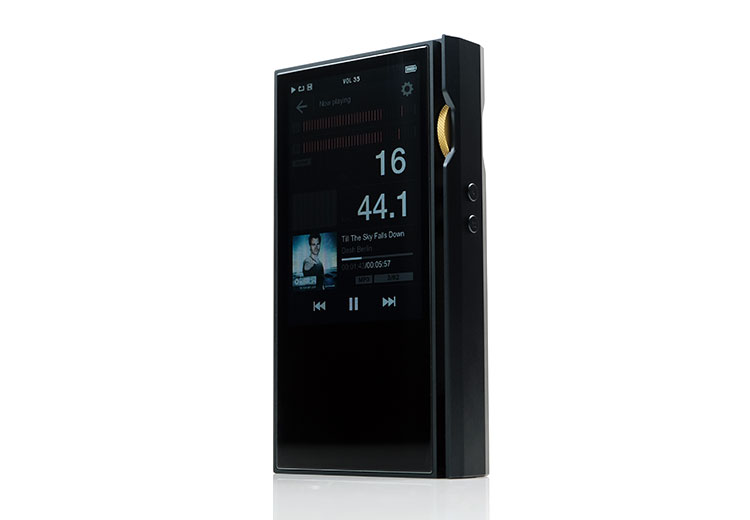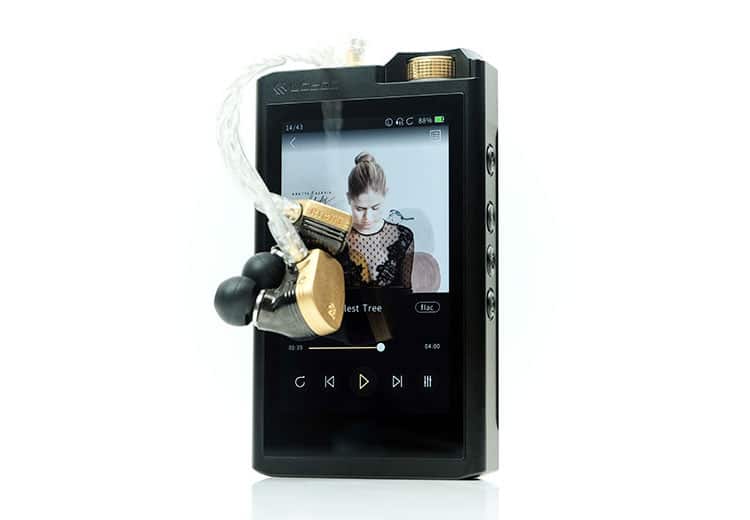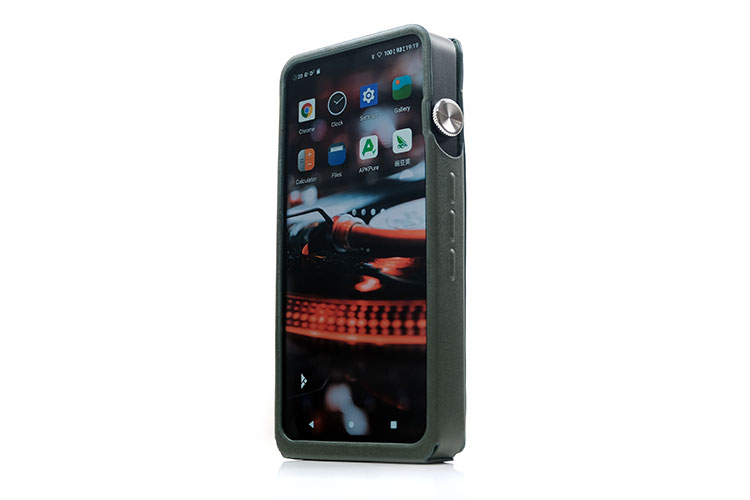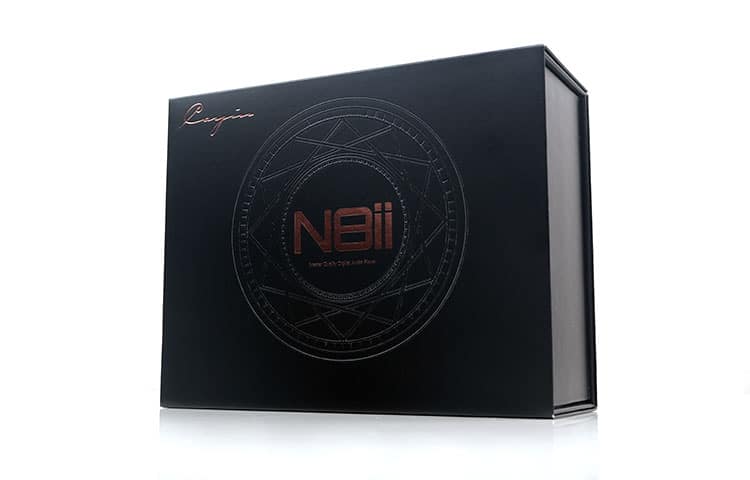Select Comparisons
Luxury & Precision P6 Pro
$3899
Probably one of the best-performing DAPs in the market today and definitely one you need to compare with the N8ii if you are in the market for quality audio from a media player. You can read our full review of the Top Gear Award-winning P6 Pro here.
Technical
Although vastly different technical implementations these DAPs do have one thing in common and that is their use of a Class A discrete designed amplification topology.
The key difference is that this is but one aspect of the N8ii feature-set which also includes a Class AB, (dual operational mode) combined with both solid-state and tube timber options. The P6 Pro keeps it all solid-state with one mode of operation for amplification output, Class A.
DAC use is an even bigger chasm with the N8ii going delta-sigma using the new ROHM DAC series in a dual channel implementation and the P6 Pro going with 100% in-house control using an R2R design which consists of high-grade 1/10,000 resistors to build a rail equivalent to 16 PCM1704K multibit chipsets in parallel.
Decoding on the N8ii is higher at 32BIT/768kHz and DSD512 including MQA 16X compared to the P6 Pro which is set at 32BIT/384kHz PCM, Native DSD256, and no MQA unfolding capability.
Output power is quite varied on the N8ii depending on the output and power mode with a peak of 750mW balanced and 480mW SE at 32Ω compared to the P6 Pro which is rated at a maximum of 700mW from a 32Ω load balanced and 180mW single-ended.
The touch-capable Android 9 on the N8ii is far more engaging and connection rich compared to the in-house touch OS on the P6 Pro which is a more limited pure-player GUI. Features such as navigation, and app expansion including WiFi capability provide a much deeper OS experience on the N8ii.
Design
For portability, the P6 Pro is both lighter and smaller with a bit more battery life, (14-15 hours). Probably one of the more compact flagships DAPs out there today. The N8ii, on the other hand, is one of the biggest, weighing in at 442g compared to 248g, and much taller, deeper, and wider.
To be fair, those dimensions allow it to accommodate a much superior 5″ AMOLED screen suitable for use with Android whereas the P6 Pro 3.5″ screen need only be legible for the text-based scrolling capability of its in-house OS. In short, the N8ii is much bigger but also much grander in appearance.
The design language though is competitive and I do like the sleek design lines of the P6 Pro’s aluminum housing. The N8ii doesn’t do much wrong here either but the aura is more Sony/Lotoo and not quite as unique as the original. Both will appeal to Western eyes in my opinion and with leather cases, the detailing is more of a moot consideration.
Both DAPs offer 4.4mm, (PO/LO) and 3.5mm PO, USB-C, and a single microSD card for memory expansion. They also have SPDIF though this is a shared 3.5mm output for the P6 Pro whereas the N8ii uses the USB-C with proprietary SPDIF cables required to be purchased.
The P6 lacks the N8ii’s I²S and OTG capability though it can act as a USB-DAC if so required. It also has a weaker VRMS output for its peak line-level output with 2 Vrms options as opposed to 3 on the N8ii.
Performance
For this comparison, I tried to get the settings as close to each other by using a VE Phonix via a balanced PO connection and having the N8ii set to Class A solid-state to match the class A SS design of the P6 Pro.
Side by side, the differences are fairly nuanced but the more immediate impression was a more ‘lifted timbre’ of the N8ii combined with an airier staging presentation.
What I mean by lifted were a sweet tone and slightly lighter note weight but one that drifted out further to the sides and above creating some additional dimensionality to the staging space.
The P6 Pro kept the staging a shade more neutral in terms of imaging and in context might sound a little more centered and straight ahead of you with the Phonix. The treble infusion was marginally less prominent combined with a little more urgency in the bass response though not by a huge amount.
The dynamic range from the N8ii in Class A solid-state is very good but not quite as rapier-like as the Class AB mode which delivers a similarly robust and punch low-end that I find so satisfying from the P6 Pro.
One thing to note and this is more delta-sigma versus R2R is the purity of the tone. You can link this a little to that immediate impression but the notes sound more polished on the N8ii compared to the rougher texture on the P6 Pro.
By rougher, I mean that in a good way with slightly stronger bass impact and contoured mids texture compared to the enhanced euphony and slightly smoother alternative from the N8ii delivery.
Lotoo Paw Gold Touch
$3199
This is still an actively sold flagship grade DAP, the Paw Gold Touch came out with an SRP close to the N8ii but since then you can find it much cheaper with the likes of Musicteck selling it for as low as $2399 which might be a good deal for some readers. You can read our full review of this Top Gear Award-winning player here.
Technical
Both DAPs are delta-sigma but the older PAW Touch Gold uses a dated single AK4497EQ chipset compared to the very new dual ROHM DAC implementation inside the N8ii.
The Touch also uses a unique CPU compared to the Snapdragon 660 inside the N8ii with no less than 3 processors handling dedicated duties. You have a fairly dated Ingenic x1000 for the wireless subsystem, a Freescale i.MX6 processor for its digital subsystem, and an Analog Devices Blackfin DF7XX DSP for the audio subsystem.
The Touch has some excellent decoding rates at up to DSD512 and PCM 768kHz which is still class-leading today and on par with the N8ii. Both devices support MQA up to 16X at the time of writing also though the Touch has no streaming capability.
Amplification output is also quite unique on the Touch with both outputs having equal output power at 500mW on a 32Ω load. Mind you, it’s a bit lower than the N8ii when you flick on the power mode with a peak output rating of 780mW on the same load going balanced.
Without the P+ mode, the N8ii drops to 480mW balanced. The peak SE output of the N8ii is marginally lower at 480mW dropping to 240mW maximum on the standard power mode.
For the OS, once again there are pros and cons as Lotoo uses its only garden-walled fixed OS. It is much faster and lighter than Android with a very quick boot-up time and fast user action response rates.
However, it is not expandable except through firmware updates and lacks app integration or regular WiFi connectivity. The BT4.2 module on the Touch is also considerably weaker and less reliable than the BT5.0 version inside the N8ii.
Design
Back in 2019, the Touch was considered a weighty DAP at 311g but in 2022 that might be considered relatively light. Especially when the N8ii weighs in at 442g and units like the DX300 MAX at 820g.
Things are getting bigger and bigger making the Touch a fairly compact-looking device. Yes, it can be operated single-handed whereas the N8ii needs both hands firmly on its base.
There are pros and cons to that naturally. The N8ii has a bigger and better screen, suitable for Android user needs with high legibility. The IPS Touch screen at 3.77″ is much more compact with a lower resolution also of 400 x 800 compared to 720p.
In truth, the OS has a compact workflow so additional screen space is not needed. The only time you could really do with more space is for long media file lists which take up more scrolling.
The design language of both is remarkably similar. Both have a low-profile black aluminum housing with slightly raised buttons on the right panel and a protected intricacy-designed gold-plated volume dial. The only difference for me aside from the size is the angular finishing of the N8ii compared to the smoother curves of the Touch.
The N8ii I/O lineup is stronger with a dedicated 3.5mm LO, I²S connectivity, and a more widely used microSD slot compared to the larger SD card feature inside the Touch. There is no onboard memory for the Touch compared to 128GB onboard for the N8ii
Both have balanced 4.4mm and SE 3.5mm PO with USB-C that doubles up for charging and USB-DAC. However, the Touch lacks OTG flash expansion capability being OTG digital audio capable only.
Performance
For this test, I went with the JH Audio Jolene using the DAPs’ respective 4.4mm PO with the N8ii setup in Class AB solid-state and varying between both the P and the P+ power mode.
Headroom here does seem to be a difference maker with the dynamic range of the N8ii having a slight edge. That is helped by slightly more treble coloration in the midrange timbre and a generally airier staging quality from an improved treble extension and presence.
The Touch seems a shade more neutral and a bit flatter in its staging delivery. Vocals sit back just a little which is something unsurprising for the AK4497EQ which tends to defer to bass punch over vocal forwardness in a lot of the implementations I have heard to date.
As such it’s missing a little of the vibrancy and sparkle of the N8ii’s Class AB tuning with a timbre that sounds perhaps denser but more rounded with less contrast. Whereas the N8ii has that necessary odd-harmonic influence that gives subtle notes a bit of a lift in the mix and injects some attention-seeking contrast in vocal timbre.
The P+ mode simply amplifies those differences, especially in the bass depth and sub-bass presence. The N8ii bass gets a bit more elasticity and volume as well as a stronger mid-bass punch.
Vocals have even greater vibrancy than the P mode leaving the Touch balanced output sounding relatively flat in its delivery and far less holographic sounding.
iBasso DX320 (AMP13)
$1599
Despite the big price difference, a lot of people might want to check out this comparison given both DAPs make use of the Korg Nutube and ROHM DAC setup. We also recently reviewed the DX320 earlier this year and you can read about it in more detail here.
Technical
Both DAPs use the same dual ROHM BD34301EKV and both offer the option to output via a Korg Nutube amplification topology.
However, the DX320 does not come with the Korg Nutube installed. Instead, you need to buy the additional AMP13 amp card which is tube-based and then swap around cards if you want a mix of sound signatures, for example, going solid-state with AMP11 MK2.
The N8ii has it all under one roof meaning you get tubes and solid state as well as a matching discrete design and a Class AB mode that you can flick through at your fingertips.
The DX320 AMP13 is also a single Nutube implementation whereas the N8ii is a dual Nutube design. That means with the N8ii you have a balanced tube output capability whereas the AMP13 will give you 3.5mm SE only with no line out option.
That has an effect on PO power ratings. The N8ii will give you more power from its tube output at 780mW into a 32Ω load compared to AMP13’s maximum of 234mW output. If you want an edge in raw power you need to use the DX320’s stock solid-state AMP11 MK2 at 1240mW balanced into 32Ω.
Since both have the same DAC, the decoding is quite similar with both able to handle up to DSD512 and PCM 32BIT/768kHz including MQA X16 and output via their respective bit-perfect architecture. The two DAPs also have BT5.0 so LDAC is not an issue either.
The DX320 Android 11 OS is a step up on the N8ii’s Android 9. Not only does it offer better support from Google and a more in-depth notifications control center but it adds some additional features that users might appreciate also. This includes Android Auto, system navigation choices, and a stronger Google Home integration.
Design
Technically, the DX320 is the bigger DAP, at least lengthwise though at 310g is much the lighter of the two compared to the taller and heavier, (425g), N8ii.
With a degree of difficulty, you can manage the DX320 using one hand given its quasi-smartphone shape, and whilst the N8ii is similarly wide its weight makes it much the two-handed experience.
I give props to iBasso for the superior and much bigger 6.5″ capacitive 60Hz IPS screen, featuring a 2340×1080 resolution and an almost borderless bezel. It is pretty responsive though the latest firmware has issues with the double tap to wake response rate which isn’t great.
I like the N8ii AMOLED screen but it is smaller at 5″, only 720p, and not as thin on the bezels. It is not quite as legible either because of the smaller screen. The 3-icon navigation of the DX320 also feels more intuitive compared to the single LED ring and gesture control of the N8ii.
For I/O, it depends on the card you are using but for AMP13, the N8ii has a clear edge here with multiple SE and balanced PO/LO compared to just dual SE for the AMP13. The DX320 does have a dedicated coaxial output, however, and not proprietary via USB-C. I²S is also a major brownie point for the N8ii which the DX320 does not offer.
Both devices have OTG digital and flash memory expansion with single microSD card slots though the N8ii has 128Gb onboard memory compared to just 64GB inside the DX320.
The battery is split between digital and analog on the DX320 which can complicate battery management and charging. With AMP13 you get a little less battery life compared to the N8ii on a like-for-like usage basis.
Performance
For this comparison, I opted for an Empire Ears Odin pairing using initial Class A with the tubes timbre via SE to match the iBasso DX320 left output then Class AB to compare with the AMP13’s hybrid right side SE output.
Left PO
If you are wondering which output of the AMP13 comes closer to the N8ii tuning it is the right port. The left port is airier, with a little more sub-bass bloom but far more dispersed in its imaging through the midrange.
Here the lows and highs take precedence with plenty of width and air but also a slight lack of comparative density and body through the mids. The tone is more euphonic and relaxed to me, even sweeter sounding compared to the N8ii. This is very much a classic relaxed and atmospheric SETA-type presentation.
The N8ii sounds denser throughout with a more centered and natural-sounding crossfeed giving the soundstage a bit more gravitas. The imaging and fundamentals for lower pitching instruments sound more ‘correct’ providing a better low-end to midrange balance as well as improved vocal richness and focus.
Right PO
You can get closer to the N8ii sound with the hybrid right PO of the DX320. The staging comes in a lot closer compared to the left PO with improved vocal intimacy on the Odin but will still cast out a little bit wider than the N8ii giving you more of a wall of euphonic vocal tones.
The punch does improve though and the mids sound a lot more filled giving vocals a stronger more intimate presence.
The N8ii is still a bit more centered in its vocal delivery but is more complex in its imaging. By that I mean it can hear it go wide or narrow in a single breath whereas the AMP13 seems to just hit you with width period.
The background from the N8ii is also blacker with no noticeable tube ping microphonics when jacking in and a clearer level of control and separation of individual instruments.
This is especially so for sensitive gear and keeping both DAP’s WiFi active. You can get a general low-grade buzz from the DX320’s AMP13 with WiFi on which hurts its dynamic range a little for me so best keep it off.
Our Verdict
Though no longer unique for tubes, the Cayin N8ii DAP still retains its flagship status and remains a class act offering an incredible array of highly resolving and enjoyable sound signatures.
Importantly, it is a DAP that has not stood still with a ton of enhancements over the original from a few years back. It has decent power, a much more engaging Android OS, and a modernized design that should generate much more appeal to the Western eye.
The synergy is so good with the N8ii. You can pair it with just about any monitor out there and either fill it with gusto and energy or keep it smooth and relaxed in tone. You get a lot of choice in how you want to tweak the output and that is just how it should be in 2022.
Nothing will remain forever and I am sure a V3 or N8iii will come out eventually but considering the original only had a brass variant for almost 5 years the N8ii should hang around for a good few years without fear which can only add to its value in the long run.
Cayin N8ii Technical Specifications
- Snapdragon 660 CPU, 6G DDR4 RAM
- Android 9 with Google Player preinstalled
- Display 5-inch Touchscreen (1280 x 720)
- Battery Life: up to 11 hours
- Bluetooth V5.0 (LDAC capable)
- WiFi 2.4G/5G
- DAC ROHM BD34301 x 2
- Continuous playback time up to 10 hours (Standard – MUSIC: FLAC, 16-bit/44kHz)
- Internal Memory 128GB [eMMC]
- External Memory microSD (Max 1TB) x1
- Streaming via LDAC and Bluetooth and Google Play Apps
- Weight 442g
- Dimensions: 77.5 mm [W] x 147 mm [H] x 25 mm [D]
3.5mm Headphone Output (Solid State)
- Output Power: Up to 720mW @ 16Ω
- Frequency Response: 20Hz-20kHz(±0.2dB)
- THD+N: 0.003%(1kHz)
- Dynamic Range: 121dB
- SNR: 121dB
- Channel Separation: 78dB(1kHz)
- Output Impedance: 0.6Ω
3.5mm Headphone Output (Tube Mode)
- Output Power: Up to 720mW @16Ω
- Frequency Response: 20Hz-20kHz
- THD+N: 0.1%
- Dynamic Range: 112dB
- SNR: 112dB
- Channel Separation: 78dB
- Output Impedance: 0.6Ω
4.4mm Balanced Headphone Output (Solid State)
- Output Power: Up to 1200mW @16Ω
- Frequency Response: 20Hz-20kHz
- THD+N: 0.001%
- Dynamic Range: 125dB
- SNR: 125dB
- Channel Separation: 111dB
- Output Impedance: 1.2Ω
4.4mm Balanced Headphone Output (Tube Mode)
- Output Power: Up to 1200mW @16Ω
- Frequency Response: 20Hz-20kHz
- THD+N: 0.05%
- Dynamic Range: 120dB
- SNR: 120dB
- Channel Separation: 110dB
- Output Impedance: 1.2Ω

